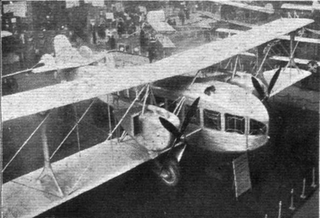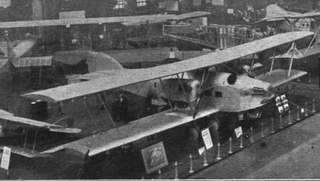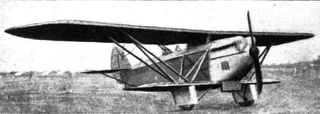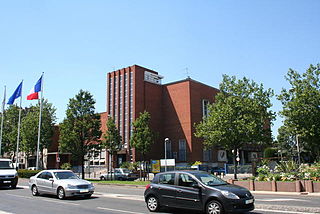
The Hanriot H.26 was a French single seat fighter aircraft prototype completed in 1923. Only one was built.

The Breguet Leviathan was a family of large all-metal biplane aircraft built in France in the early 1920s. The Breguet XX and XXI were notable for being powered by Breguet-Bugatti multiple engines, in two forms. The Breguet XXI was powered by individual Breguet-Bugatti U.16 engines initially and Lorraine-Dietrich 8b engines in tandem later. The Breguet XXII had accommodation for about twenty passengers and was destroyed during a 1923 transport aircraft competition. Development of all three aircraft types was halted largely due to technical issues with power-plants and aircraft structure.

The Potez VIII was a French training aircraft which first flew in 1920. Originally it had a very unusual vertical inline engine and a four-wheeled undercarriage, though the production version was more conventional.

The Potez XVIII was a French airliner from the early 1920s, a three engine biplane carrying up to twelve passengers.
The Potez 26 was a single seat fighter aircraft designed and flown in France in the mid-1920s. It did not reach production.
The Potez 27 was a French reconnaissance biplane first flown in 1924. 175 were operated by the Polish Airforce, most built in Poland by PWS under licence. Others went to Romania, where they were also used as light bombers.

The Caudron C.27 was a French biplane, a two-seat basic trainer which also competed successfully in the 1920s.
The Caudron C.99 was a French light bomber and reconnaissance aircraft. The only example flew with different engines in the mid-1920s.

The Caudron C.68 was a two-seat French training and touring aircraft, built in the early 1920s, which attracted interest at the time because of its simple and fast wing folding arrangement. Only a few were produced.

The Caudron C.67 was a simple single seat biplane with a low powered engine. It was built and flown in France in 1922.

The Caudron C.39 was a French three engined biplane with a cabin for six passengers when the aircraft was equipped as a landplane or four passengers when on floats. It was flown with some success in competitions in 1920 and 1921.

The Caudron Type O was a French single seat air racing biplane flown in 1914.
The Caudron Type H was a collective name for three different Caudron designs of 1912-3. One of these was an amphibious three seat biplane built for the French military. Two were completed, one appearing at the Paris Aero Salon in November 1912.

The Caudron Type L was a two-seat French pusher configuration amphibious biplane, flown around 1913 and intended for naval use.
The Caudron Type B Multiplace was a large French biplane designed to carry up to five passengers in a cross country time trial of 1912. It was destroyed early in the event.

The Descamps 17 A.2 was a two-seat reconnaissance fighter built under a French government programme of 1923. Two versions, with different engines, were tested and six examples were built under licence by Caudron as the Caudron C.17 A.2.

The de Marçay 2 C1 was a single seat biplane fighter designed in France and first flown in 1919. It did not go into production.

The Nieuport-Delage NiD 580 R.2 was a contender for a French government contract for a long range, two seat reconnaissance aircraft, issued in 1928. There were eight prototypes in the 1931-2 contest and the NiD 580 was not selected for production.
The Morane-Saulnier MS.300 and MS.301 were French parasol wing introductory trainer aircraft, first flown in 1930. They differed only in engine type. Neither reached production but were developed into two similar trainers, the MS.230 and MS.315, which were made in large numbers.




























